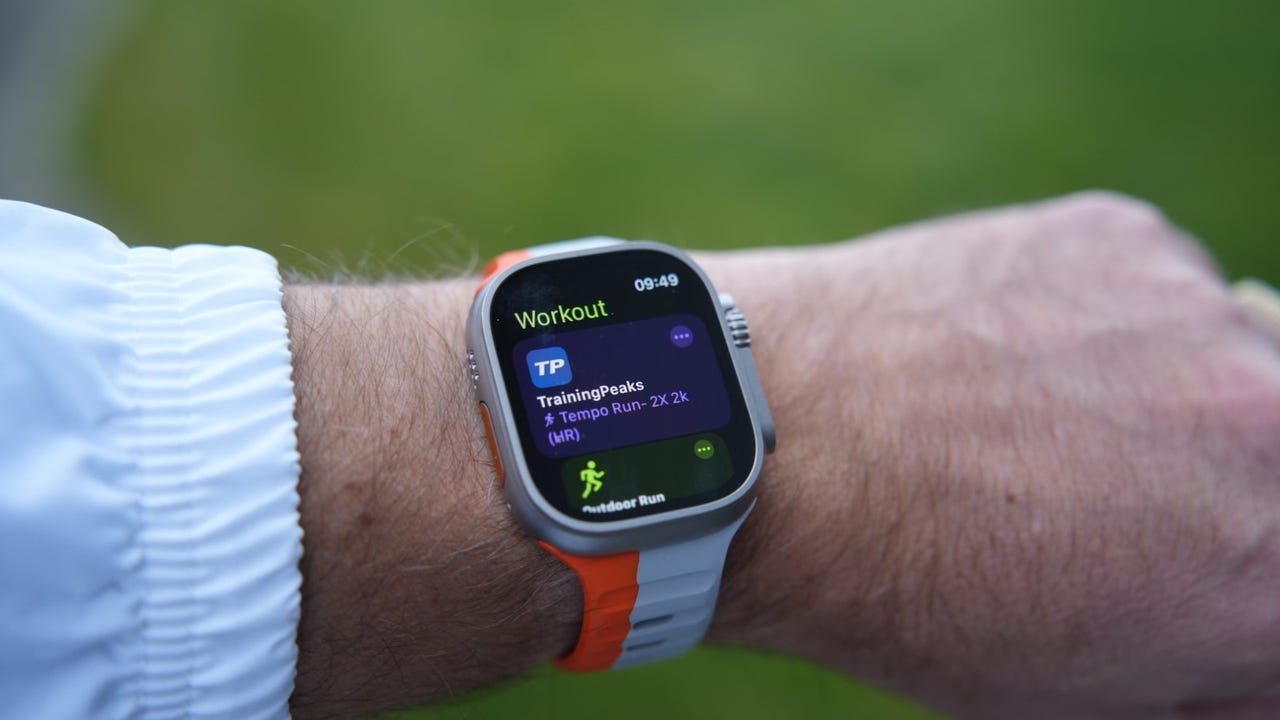
When the Apple Watch Ultra first debuted last year, many comparisons were made between it and sports watches from Garmin, Coros, Polar, and Suunto. But that first-generation Watch Ultra, it turns out, wasn’t quite ready to take over the wrist from dedicated GPS sports watches. Still, the potential was certainly there.
One year later, when the Watch Ultra 2 along with WatchOS 10 arrived, it became clear that Apple was continuing to progress its smartwatch platform into one suited for athletes. One feature revealed at WWDC was the introduction of APIs designed for exercise developers to send custom workouts directly into the Apple Watch Workout app. Watch users could already create custom workouts on the watch and use them with the Workout app; now, the ability to sync those workouts from another source or provider streamlines the experience and also provides more detailed analysis of the workouts outside of the Workout app experience.
Also: I spent a week with the Apple Watch Ultra 2 and here’s what stood out the most
A couple of developers have rolled out this uphold; for the past week, I’ve been testing this integration from TrainingPeaks, one of the most popular coaching platforms available for athletes. I was set up with evaluate accounts on TrainingPeaks and provided with several running and cycling workouts to try out on my own, along with a couple of coaches providing some guidance during the testing period. Let’s take a closer look at my experiences on the track and bike path.
Running
I spend most of my exercise time running or using the Hydrow rowing machine so it was easy for me to find a local track and get out to evaluate the running workout functionality. I wouldn’t say that winter in the Pacific Northwest is the best time to get outside and run, but I don’t run inside so I was ready to take on the challenge in the cold, dark, and wet conditions.
After signing into the evaluate TrainingPeaks account and selecting the proper options to connect TrainingPeaks with the Apple Watch, the workouts were synced over to the Apple Watch Ultra 2. Once I arrived at the track I selected the workout I wanted to complete — the workout appeared in the Workout app with the TrainingPeaks logo to make the workout stand out clearly from Apple’s default workout options.
Also: The best Garmin watches you can buy
I selected the workout, chose the outdoor running option, and designated the lane I was planning to run in around the track. The Apple Watch Ultra 2 provided audio directions for the planned distance and target heart rate. As I ran, the watch informed me if I was above or below the desired heart rate zone and this honestly was one of the most useful aspects of the experience to keep me on track for the planned heart rate-based workout.
Another extremely helpful indicator on the watch was a quick visual showing me the status of my progress, in blue segments around a circle. I could quickly glance down and see how far I had left in a particular segment to manage my reported heart rate.
Also: Apple Watch Ultra review
After the run, the workout appeared in Apple Workout and was also synced over to the TrainingPeaks app on my iPhone. Various details appeared in both apps while the data in TrainingPeaks fed into the TrainingPeaks data and metrics. I was able to accomplish 96-97% compliance with the planned training scheme and it is clear that this success was due to the guidance provided through the Apple Watch.
Cycling
While I ride bikes often, it is primarily for commuting purposes and often on an e-bike. I dusted off my trusty 1994 Bridgestone XO-4 bike and checked my Garmin speed and cadence sensors. It turns out that I have the original sensors that connect via ANT+ so I was unable to connect them to my Apple Watch Ultra 2. If I continue cycling for exercise I may have to upgrade to the newer Bluetooth model sensor.
WatchOS 10 brought some awesome functionality to the cycling experience, helping to turn a connected iPhone into a powerful bike computer. In addition to supporting Bluetooth connections to cycling accessories, when you start a cycling workout on your Apple Watch the workout appears as a live activity on your iPhone with various metrics and guidance provided on the full iPhone display.
With custom training plans synced from TrainingPeaks to the Apple Watch Ultra 2, that TrainingPeaks experience appeared on the live activity screens as well. This meant that guidance on my planned heart rate appeared on the iPhone display, along with information on the next upcoming segment of the training scheme. You can easily swipe left and right on these iPhone displays to view an extensive amount of metrics and data on your ride.
I would never use a watch to guide me through a training scheme on a bike since I need to stay focused on the path or road ahead. Having the watch power the iPhone display was an awesome experience and the iPhone can now easily serve as my primary bike computer.
Also: The best smartwatches you can buy: Apple, Samsung, Google, and more compared
Garmin has released some amazing GPS sports watches over the past few years and I usually wear a Garmin on one wrist and a smartwatch on my other wrist. Apple’s continued development of WatchOS and uphold for third-party developers is seriously challenging my need for a dedicated GPS sports watch for training plans, activity tracking, and wellness assessments.
I scheme to continue exploring Apple’s uphold for custom workouts; it is an exciting time to be using wearable technology that is improving so rapidly.

